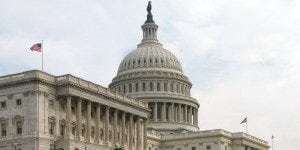
In another party-line vote, the Senate Appropriations Committee on Thursday sent the funding bill for the Environmental Protection Agency to the full chamber for approval.
The fiscal 2017 Interior, Environment, and Related Agencies Appropriations Bill would provide just over $32 billion for – as the name suggests – the EPA, Interior Department and its sub-agencies, and a handful of separate federal organizations such as the Smithsonian Institution.
Of that, $8.1 billion would go to the EPA, $31.2 million below funding in the current budget and $167 million less than the Obama administration requested for the fiscal year beginning Oct. 1.
As was the case during a Senate Appropriations subcommittee markup of the bill on Tuesday, as well as the House Appropriations Committee’s vote on its version of the legislation on Wednesday, Republican lawmakers said the measure supports necessary environmental programs while holding the line against EPA regulatory overreach and Democrats countered that it would undermine crucial clean air and water projects.
“When it comes to funding for the EPA the subcommittee chose to prioritize programs that do some very substantive and concrete things to improve the quality of our environment,” said Senator Lisa Murkowski (R-Alaska), chairwoman of the Appropriations Interior, Environment, and Related Agencies Subcommittee, citing examples including meeting the request for an additional $157 million for the Drinking Water State Revolving Fund.
She added, though, that “in order to provide for these funding increases you’ve gotta have an offset, you’ve gotta reduce somewhere else. This bill cuts areas within EPA’s regulatory budget where the EPA’s authority has been challenged in the courts.”
Specifically, funding for regulatory programs facing legal challenges would be cut by about 10 percent, according to a Murkowski spokesperson.
The EPA’s Clean Water Rule and Clean Power Plan are both under federal court stays, meaning the EPA cannot move forward with their implementation.
The Clean Power Plan would require states to meet federally set emissions caps for existing coal-fired power plants, but was frozen in February by the U.S. Supreme Court while a massive challenge to the rule advances through the federal court system.
Sen. Tom Udall (D-N.M.), ranking member of the Appropriations Interior subcommittee, submitted an amendment to strike 12 provisions that he described as “poison pill riders” on the Clean Water Rule, Endangered Species Act, and other regulations. Identical measures were struck from last year’s iteration of the bill and are sure to be rejected by the White House, the lawmaker said.
“I’m not sure how many times we have to go through this process before it sinks in that adding controversial language doesn’t help get spending bills passed into law,” said Udall, whose amendment died in a partisan 14-16 vote.
Most amendments during Thursday’s hearing addressed items unrelated to the EPA’s emissions regulations, such as funding for emergency wildfire suppression.
Sen. Shelley Moore Capito (R-W.Va.) discussed but withdrew an amendment that would prevent the EPA from expending any resources on the Clean Power Plan as long as the Supreme Court freeze remains in place. The lawmaker does plan to put forward the amendment when the bill goes to the Senate floor.
The EPA has acknowledged that it is continuing to conduct preparatory work on the rule in anticipation of an eventual court victory, including providing guidance to states that are moving forward with their implementation plans. EPA has, however, halted work related to the implementation of the rule, as is required by the Supreme Court stay. On Thursday, the agency said it was considering new details for public comment on the Clean Energy Incentive Program, a component of the Clean Power Plan intended to promote voluntary investment in renewable energy that goes beyond that required by the rule.
It was not immediately clear Thursday when the Senate or House bills would be considered on their respective floors.
The House Interior funding legislation prohibits the EPA from implementing new regulations on greenhouse gas emissions from new and existing power plants, a direct shot at the agency’s Clean Power Plan and New Source Performance Standards. The New Source Performance Standards, which would effectively require that all new-build coal-fired power plants use carbon capture and sequestration technology, would also be fully stripped of funding under the bill.
While the White House has not issued direct veto threats against the bills, it has made clear that President Barack Obama would veto any legislative effort to undo the Clean Power Plan.